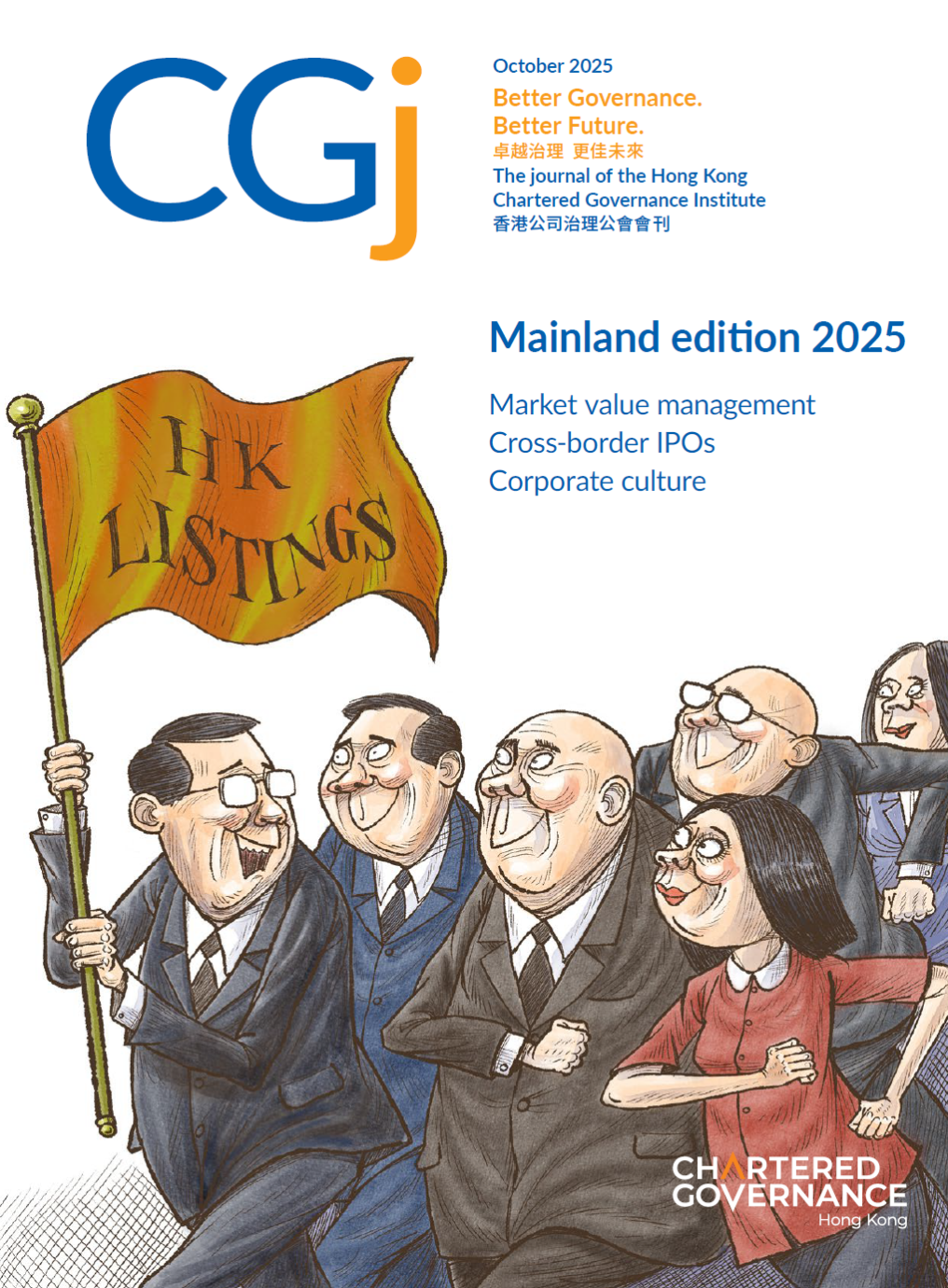
Strategic design of boards
Loretto Leavy FCG, Researcher, University of Exeter Business School, and Ruth Sealy, Professor of Leadership, Henley Business School, and Honorary Professor, University of Exeter Business School, explain how their board behavioural dynamics framework provides Hong Kong boards with the practical tools to navigate recent regulatory changes, while building more effective collective leadership.
Highlights
- the new board behavioural dynamics framework equips Hong Kong boards with a structured, proportional approach to navigate the 2025 governance amendments
- by integrating six core behavioural processes with three maturity approaches, boards can transform regulatory compliance into strategic leadership capability
- the framework enables cohesive board development by aligning key processes such as appointments, evaluations and succession planning under a unified governance architecture
Hong Kong’s evolving governance requirements present a strategic opportunity, rather than posing isolated compliance challenges. The recent amendments to the Corporate Governance Code and related Listing Rules, effective from 1 July 2025, have introduced new requirements covering biennial board performance evaluations, skills matrix reporting, tenure restrictions, enhanced director training and increased reappointment disclosures. Instead of addressing these changes as separate tasks, boards can leverage this moment to establish an integrated governance architecture that creates proportional solutions matching their external and internal contexts.
Our new research – from the University of Exeter Business School and Henley Business School, developed in collaboration with The Chartered Governance Institute UK & Ireland and validated by over 600 governance professionals – presents a proven methodology to transform these regulatory amendments into strategic advantages. The Board Behavioural Dynamics handbook (the Handbook), published on 1 July 2025, is a framework that reveals how boards can systematically develop their collective capability through six interconnected processes and three maturity approaches, each tailored to achieve best fit for the board’s specific circumstances, rather than pursuing a universal best practice approach.
The best fit approach
Research demonstrates that board effectiveness derives equally from decision-making tasks and how directors collaborate as a group.
However, practice, regulation and academic resources have not so far adequately explained how to optimise social dynamics within complex governance ecosystems. Board behavioural dynamics represents the board’s ability to come together effectively as a collective body, addressing this critical gap in structured approaches to enable boards to function as cohesive decision-making bodies.
Rather than treating the updated governance processes as isolated activities, our Handbook reveals how boards can systematically develop their collective capability through interconnected processes that reinforce one another.
The Handbook represents a process benchmark using three maturity approaches for six core processes within their wider ecosystem. For governance professionals and advisers, the maturity maps provide the ability to plot contextual pressures, procedural steps and outcomes across the three approaches, thereby allowing additional insights into process-level responses. For chairs and directors, the maturity matrix gives a high-level summary that can assist in driving better discussions of the strategic and explicit approach to be adopted.
Let’s review the underlying elements in more detail, first looking at the maturity levels and then the individual processes, while being mindful of the changed Hong Kong governance landscape.
A useful Maturity Matrix table, outlining the three maturity approaches and the six core processes, can be found on page 3 of our Handbook, which can be downloaded from here.
The three maturity approaches
Each board operates within different circumstances that drive different proportional responses. Our research found that boards do not apply the same level of sophistication for each process. To understand the appropriate proportional response, we found that it is imperative to understand the board’s overall context and the actual and expected outcomes. The optimal maturity level depends on this ecosystem, rather than on pursuing a universal approach.
Therefore, the board is continually impacted by a complex ecosystem of interdependent chair-led processes, contextual pressures from the external and internal environment, and the board’s expected and actual outcomes.
These drivers of board change include:
- institutional contexts such as legal, regulatory, sector, societal and economic pressures
- organisational contexts such as the effect of strategy and product, performance (including risks) and firm characteristics (including impacts from the organisation’s investors and funders)
- board-level contexts such as barriers or opportunities from core board elements (diversity, expertise, interpersonal relationships and board structure), highlighted through board processes, the perception of changes required or the resources available, and
- outcomes, both actual (such as demographic diversity) and expected (such as reporting of board processes), can also influence the ecosystem in which boards operate by creating pressures, barriers or opportunities.
In the chair-led six processes, we were able to discern that processes are deployed in three distinct patterns – Baseline, Adaptive and Extensive – implicitly reflecting their contextual drivers of change, as well as their outcomes. We refer to these patterns as maturity approaches.
Baseline approach
‘Baseline’ is basic diligence often characterised by an awareness of processes. In this approach, processes may not be actively enacted and, where they are, this may be through implicit discussions.
This approach may suit boards that are in a steady state, those that have just become listed or those with a dominant stakeholder presence. Boards that are not explicitly aware of their circumstances may be adopting this approach without recognising the need for further action. The Baseline approach reflects the process approaches identified in a proportion of the sample, rather than the basic requirements specified by regulators.
Adaptive approach
‘Adaptive’ is actively assessing positions to be more responsive to strategic business needs. In this approach, boards start to build awareness of the need to align their board behavioural dynamics processes to achieve board effectiveness.
The Adaptive approach suits boards that are undergoing change, most commonly in response to strategic, product and market pressure, or to anticipating change to preempt such pressure. The Adaptive approach generally reflects the standards expected of listed firms in the UK Corporate Governance Code (UK Code).
Extensive approach
‘Extensive’ is focused on strategic business needs, as well as interpersonal relationships, and recognises how the processes are interlinked. This is the most comprehensive and proactive approach and is suited to boards undergoing significant change.
The Extensive approach generally relates to the standards expected by UK listed firms to meet the UK Code, in addition to the full remit of the guidance notes that accompany the UK Code.
For Hong Kong governance professionals, the framework’s three maturity approaches provide practical guidance for determining proportional responses. Boards need not pursue the most extensive approaches universally – the optimal maturity level depends on the board drivers, including organisational context, stakeholder expectations and strategic requirements. A board experiencing significant strategic transformation may require extensive maturity across multiple processes, while a stable organisation might achieve effectiveness through Adaptive approaches tailored to specific needs.
It is important to understand the process nuances to this and, in particular, how the updated regime interplays at each process.
Behavioural dynamics processes
The six processes were identified and then validated through our research. We believe that these six core processes represent the bundle of processes that underpin board behavioural dynamics. We have used action-orientated verbs for the processes to ensure a differentiation is made between the action to be taken and the outcome of the action, for example, the appointing process results in an appointment.
Appointing
Hong Kong’s governance framework mandates formal, rigorous and transparent appointment procedures. The 2025 amendments introduce interlinking requirements for appointments such as enhanced skills matrix requirements and a greater focus on nomination committee diversity, essentially mandating at least an Adaptive approach.
Baseline approaches rely on agency-led recruitment, seeking like-for-like replacements – adequate for stable boards, but this may limit strategic evolution or the envisaged increased focus on skills and diversity. Adaptive approaches align recruitment to strategic needs within an Adaptive skills matrix, thereby connecting appointments to their broader composing and designing objectives. Extensive approaches integrate outputs from all behavioural dynamics processes, assessing behavioural balance and interpersonal dynamics, alongside strategic skills.
Inducting, training and developing
Hong Kong’s 2025 amendments introduce specific director training requirements – continuous professional development for all directors, plus 12 hours for experienced international directors or 24 hours for other first-time directors within 18 months of appointment.
Baseline approaches address only legal, governance and compliance requirements, which may be adequate in steady state boards, but in more complex boards it may limit capability development. Adaptive approaches introduce structured programmes incorporating strategic and operational perspectives, as well as legal, governance and compliance requirements. Extensive approaches prioritise business engagement, with directors actively engaging with operations, customers and stakeholders to build practical strategic insights into the business and its developing needs.
This process transforms from regulatory compliance into strategic capability building that enhances board effectiveness throughout director tenure. This spectrum should be reviewed to ensure that the mandatory training implemented is a best fit for the directors and the overall board.
Evaluating and acting
Hong Kong now expects biennial board performance reviews, plus enhanced annual director assessments for reappointment, focusing on time commitment and contribution.
Critical gaps exist where boards and committees evaluate but fail to act on the results. Baseline approaches do not explicitly follow through on actions and do not explicitly review directors. Adaptive approaches implement structured processes for boards, committees and directors with clear action planning, using insights to inform development and composition decisions. Extensive approaches create continuous improvement engines that explicitly connect evaluations and actions across all behavioural dynamics processes.
Hong Kong’s biennial cycle presents challenges as issues are unlikely to align to a two-year period and reappointments will not always fall within these windows. We would recommend that an annual review take place to ensure that the new director assessment for reappointing is delivered effectively.
NED succession planning
Hong Kong’s nine-year INED tenure limit creates succession planning requirements. In our research, we found that market practice typically emphasises executive over NED succession in boards.
Baseline approaches focus on tenure tracking without strategic integration – this aligns with the new INED tenure focus. More complex or diverse boards may want to review Adaptive and Extensive approaches. Adaptive approaches introduce strategic planning aligned to business needs, potentially integrating with the new skills matrix requirement. Extensive approaches consider the impact of both skills evolution and interpersonal relationships, with transition sequencing considered over three time horizons.
Hong Kong’s phased implementation through 2028 and 2031 sets out transition periods for developing the most appropriate approach for your board.
Composing and designing
Hong Kong addresses multiple composition elements, including independence requirements, diversity expectations and updated skills matrix requirements. As found in our research, this is often via separate subprocesses rather than an integrated design approach.
Baseline approaches provide basic statements of the key subprocesses. Adaptive approaches implement skills matrices with strategic needs assessment and systematic diversity evaluation – this is likely to be the minimum approach envisaged in the new skills matrix requirements. Extensive approaches deliver a comprehensive architecture that balances strategic and interpersonal requirements with explicit gap identification and improvement planning.
The framework suggests a three-step approach with a wide composition review, reviewing the ecosystem and key approaches, and puts forward plans to address gaps. This gives rise to a systematic methodology for integrated board design, rather than fragmented compliance exercises.
Reappointing
Hong Kong’s 2025 amendments significantly enhance reappointment disclosure requirements, mandating detailed assessment reporting on time commitment and contribution – this envisages a more explicit approach that is at least Adaptive.
Baseline approaches treat reappointment as automatic renewal, unless concerns arise specifically from the director. These discussions are often implicit. Adaptive approaches implement a systematic assessment that takes account of expertise and contribution aligned with evolving needs. Extensive approaches transform reappointing into strategic culmination points that integrate all behavioural dynamics processes.
The Handbook formulates detailed steps for optimising board effectiveness through deliberate capability management.
Implementing best fit solutions
The July 2025 amendments to Hong Kong’s Corporate Governance Code and related Listing Rules represent a strategic opportunity for boards to move beyond fragmented compliance responses toward an integrated governance architecture. Rather than treating biennial performance reviews, enhanced training requirements, skills matrix disclosures, tenure restrictions and reappointment obligations as separate regulatory tasks, boards can leverage these changes to establish proportional solutions that achieve best fit for their specific circumstances.
Our board behavioural dynamics framework reveals how the systematic development of collective board capability requires all six core processes to function as interconnected components, rather than as isolated activities. When boards implement appointing, inducting and developing, evaluating and acting, succession planning, composing and designing, and reappointing as a coordinated bundle, they create a governance architecture that reinforces strategic alignment while delivering regulatory compliance.
In a previous article, published in the May 2025 edition of CGj, we developed this further with a review of how the nomination committee could be utilised to effect this change. As outlined in that analysis, integrating oversight of these six processes under nomination committee leadership offers Hong Kong boards the most effective delivery mechanism for this comprehensive approach. By bringing together processes that are currently managed separately across different committees and individuals, nomination committees can ensure strategic alignment, reduce duplication of effort and create more cohesive board development strategies.
The Handbook provides Hong Kong boards with market-researched guidance for implementing governance changes that create lasting strategic advantages. Through best fit proportional solutions, boards can build the collective capability required to navigate increasingly complex business environments while meeting evolving stakeholder expectations.
Loretto Leavy FCG, Researcher, University of Exeter Business School, and Ruth Sealy, Professor of Leadership, Henley Business School and Honorary Professor, University of Exeter Business School
The Board Behavioural Dynamics handbook can be downloaded from here. The previous article by the authors, mentioned above, was published in the May 2025 edition of CGj.


